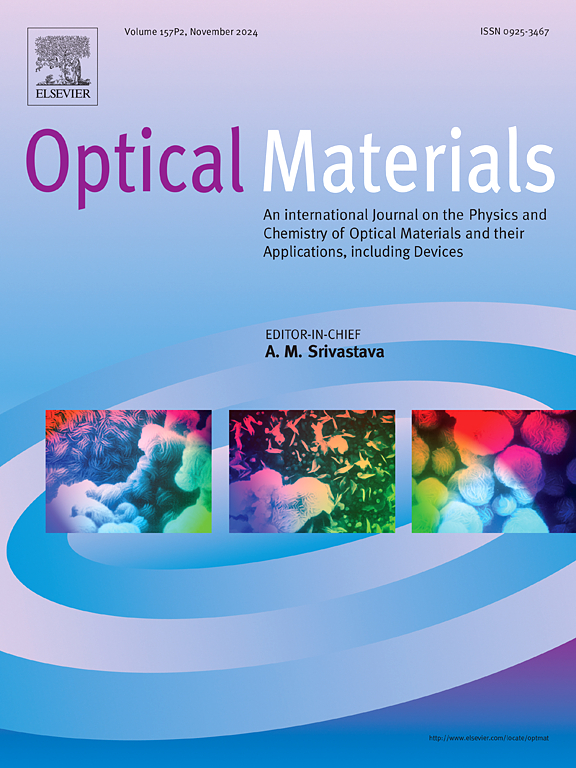Highly efficient Eu3+→Tb3+ energy transfer and colour tunable Y4Al2O9: Eu3+, Tb3+ nanophosphors: A promising material for concealed fingerprint analysis and solid-state lighting
IF 3.8
3区 材料科学
Q2 MATERIALS SCIENCE, MULTIDISCIPLINARY
引用次数: 0
Abstract
Color-tunable Y4Al2O9: Eu3+, Tb3+ (YAM: Eu3+, Tb3+) nanophosphors (NPs) are synthesized using a solution combustion approach using Moringa Oleifera (M.O.) leaves extract as fuel. These NPs are extensively characterized through X-ray diffraction (XRD), Field Emission Scanning Electron Microscopy (FE-SEM), transmission electron microscopy (TEM), and X-ray photoelectron spectroscopy (XPS). A comprehensive investigation is conducted on their luminescent properties, concentration quenching mechanism, energy transfer (ET) dynamics, luminescence kinetics, thermal stability, and potential applications. Under near-ultraviolet (n-UV) excitation at 365 nm, YAM: 5 %Eu3+, 2 %Tb3+ NPs exhibited bright green fluorescence at 543 nm due to an efficient Eu3+→Tb3+ ET process with 93.58 % efficiency, following a dipole-dipole interaction mechanism. The Tb3+→Eu3+ ET enabled tunable emissions from red to green by varying dopant concentrations. When combined with n-UV LED chips, these NPs produced red, green, and white emissions, highlighting their potential for white light emitting device (w-LEDs) applications. Thermal stability is excellent, retaining 92.8 % luminescence at 420 K, with an activation energy of 0.3047 eV, Sr of 0.718 % K−1 at 300 K, and an internal quantum efficiency (IQE) of 87.58 %. Integration with BAM: Eu2+ blue phosphors and a 370 nm n-UV chip enabled fabrication of w-LEDs with a high color rendering index (CRI) Ra = 91 and a correlated color temperature (CCT) of 5232 K, suitable for indoor lighting. Beyond solid-state lighting, these NPs demonstrated high-resolution latent fingerprints (LFPs) detection. In this work, we proposed a comprehensive strategy for quantifying the fluorescence contrast of fingerprints, integrating both fluorescence intensity and color indices through photoluminescence (PL) spectroscopy analysis. The intensity index (I) reflects the relative fluorescence intensity between the fingerprint and its background, while the color index encompasses three components: hue, saturation, and value (L), with hue and saturation represented collectively by the chroma (C) parameter. The overall fluorescence contrast is defined as the product of relative intensity, chroma, and the common logarithm of the value index (I·C·log L). This approach is employed to quantify fingerprints deposited on various substrates using optimized YAM:5 %Eu3+, 2 %Tb3+ nanoparticles, exhibiting high sensitivity, accuracy, and an excellent detection limit. Thus, the developed fluorescence contrast quantification and enhancement method using YAM:5 %Eu3+, 2 %Tb3+ NPs provides a novel and effective tool for practical forensic analysis and personal identification. The multifunctionality, stability and color-converting capabilities of YAM:5 %Eu3+, 2 %Tb3+ NPs position them as promising materials for w-LEDs and forensic investigations.

高效Eu3+→Tb3+能量转移和颜色可调Y4Al2O9: Eu3+, Tb3+纳米荧光粉:一种有前途的隐藏指纹分析和固态照明材料
以辣木(Moringa Oleifera)叶提取物为燃料,采用溶液燃烧法合成了颜色可调的Y4Al2O9: Eu3+, Tb3+ (YAM: Eu3+, Tb3+)纳米荧光粉。通过x射线衍射(XRD)、场发射扫描电子显微镜(FE-SEM)、透射电子显微镜(TEM)和x射线光电子能谱(XPS)对这些NPs进行了广泛的表征。对它们的发光特性、浓度猝灭机理、能量传递动力学、发光动力学、热稳定性和潜在应用进行了全面的研究。在365 nm的近紫外(n-UV)激发下,YAM: 5% Eu3+, 2% Tb3+ NPs在543 nm处表现出亮绿色荧光,这是由于Eu3+→Tb3+ ET过程效率为93.58%,遵循偶极子-偶极子相互作用机制。Tb3+→Eu3+ ET通过改变掺杂浓度实现了从红色到绿色的可调发射。当与n-UV LED芯片结合时,这些NPs产生红色,绿色和白色发射,突出了它们在白光发射器件(w-LED)应用中的潜力。热稳定性优异,在420 K时保持92.8%的发光,活化能为0.3047 eV, 300 K时Sr为0.718% K−1,内量子效率(IQE)为87.58%。与BAM: Eu2+蓝色荧光粉和370 nm n-UV芯片的集成使w- led具有高显色指数(CRI) Ra = 91和相关色温(CCT)为5232 K,适合室内照明。除了固态照明,这些NPs还展示了高分辨率的潜在指纹(lfp)检测。在这项工作中,我们提出了一种综合的策略来量化指纹的荧光对比,结合荧光强度和颜色指数,通过光致发光(PL)光谱分析。亮度指数(I)反映指纹与其背景之间的相对荧光强度,颜色指数包括色相、饱和度和值(L)三个组成部分,色相和饱和度由色度(C)参数共同表示。整体荧光对比度定义为相对强度、色度和值指数的公共对数(I·C·log L)的乘积。该方法采用优化的YAM: 5% Eu3+, 2% Tb3+纳米颗粒,对沉积在不同基底上的指纹进行定量,具有较高的灵敏度、准确性和良好的检测限。因此,利用YAM: 5% Eu3+, 2% Tb3+ NPs的荧光对比定量和增强方法为实际法医分析和个人识别提供了一种新颖有效的工具。YAM: 5% Eu3+, 2% Tb3+ NPs的多功能,稳定性和色彩转换能力使其成为w- led和法医调查的有前途的材料。
本文章由计算机程序翻译,如有差异,请以英文原文为准。
求助全文
约1分钟内获得全文
求助全文
来源期刊

Optical Materials
工程技术-材料科学:综合
CiteScore
6.60
自引率
12.80%
发文量
1265
审稿时长
38 days
期刊介绍:
Optical Materials has an open access mirror journal Optical Materials: X, sharing the same aims and scope, editorial team, submission system and rigorous peer review.
The purpose of Optical Materials is to provide a means of communication and technology transfer between researchers who are interested in materials for potential device applications. The journal publishes original papers and review articles on the design, synthesis, characterisation and applications of optical materials.
OPTICAL MATERIALS focuses on:
• Optical Properties of Material Systems;
• The Materials Aspects of Optical Phenomena;
• The Materials Aspects of Devices and Applications.
Authors can submit separate research elements describing their data to Data in Brief and methods to Methods X.
 求助内容:
求助内容: 应助结果提醒方式:
应助结果提醒方式:


